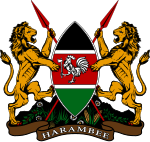Senate of Kenya
1963 establishments in Kenya1966 disestablishments in Kenya2013 establishments in KenyaEngvarB from May 2013National upper houses ... and 1 more
Senate of Kenya

The Senate of the Republic of Kenya is one of the two Houses of the Parliament of Kenya, along with the National Assembly. The Senate was first established as part of Kenya's 1963 Constitution. After being abolished in 1966, the Senate was re-established by Article 93 of the new 2010 Constitution to represent counties' interests as well as pass legislation concerning counties.
Excerpt from the Wikipedia article Senate of Kenya (License: CC BY-SA 3.0, Authors, Images).Senate of Kenya
Parliament Road, Nairobi Upper Hill
Geographical coordinates (GPS) Address Nearby Places Show on map
Geographical coordinates (GPS)
| Latitude | Longitude |
|---|---|
| N -1.2899 ° | E 36.82 ° |
Address
Kenya Parliament Buildings
Parliament Road
40476 Nairobi, Upper Hill
Nairobi County, Kenya
Open on Google Maps









